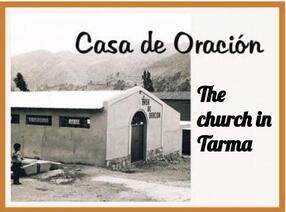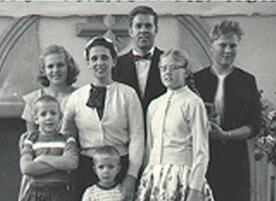Chapter 5: Welcome to Tarma - Jan. 7th 1967
AS TOLD BY GRO AGERSTEN
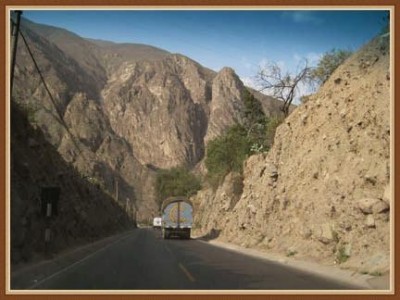
The congregation in Tarma had prepared a welcome party for us on Sunday, January 8th, but since the documents for our residence permit weren’t finished yet, we could only go for a brief visit over the weekend. This was the city that would be the base for our ministry for the next couple of years, and we were excited to finally see it! We were traveling with the family Lindgren in their Volvo Duet. As we left Lima, we drove through many of the poor neighborhoods and villages in the desert surrounding the city. They looked so pitiful and impoverished. We felt sorry for these people who had to live under such poor conditions. What made it look even worse was that there was hardly a green straw to be seen anywhere!
The first few miles were on a nicely paved road, so we almost did not notice the incline until we were at about 1500 meters altitude (4900 feet). After that, the curves and inclines really became noticeable!. The road seemed to go straight uphill the first 75-90 miles and then curved along deep precipices and narrow gorges.

It could not be compared to any roads back in Norway. We drove into a canyon where the road reminded us a little of the Norwegian Trollstigen. The mountain walls on this road, though, were bare and standing straight up, and the mountains looked very different than those in Norway. Nothing was growing on them; there was only sand and rocks.This was partially due to the fact that it almost never rains on the western side of the Andes, and also because of the high altitude. We climbed higher and higher up in the mountains and eventually arrived at the mountain pass Ticlio. The railway to Huancayo also passed through here and is said to be the world's highest railway for passengers. Now, we had driven uphill for 90 miles. The air up here was thin and we had to move slowly, but we ventured out into the thin and cold air to take a picture in front of the sign showing the altitude at Ticlio:15, 807 ft. above sea level!
We could see mountain peaks right around us topped with "eternal" snow. It was fun to see the llama herds and large flocks of sheep with their young shepherds along the road, too. The children in the family are the ones who usually get the jobs as shepherds.
As Norwegians, we felt that we were used to mountains and mountain roads, but this trip was very different from anything we had experienced so far. After the highest point, the road continued down to the plateau at the mining town of La Oroya. Here the mountains were colored by waste from the mining of mostly copper and zink. It looked barren and desolate, and it was also very cold. The women were all dressed in thick, wide skirts and they had woolen blankets over their backs and shoulders.
TARMA: "The Pearl of the Andes"

Our drive continued over another mountain that was not as tall as the previous one, and there before us lay the Tarma Valley. Finally, we could see the final destination of our long journey!
Tarma is beautifully situated down in the bottom of the valley and surrounded by mountains. Among the eucalyptus trees, we could see small clusters of houses, farms, fields, and farm plots with corn, wheat, potatoes, and vegetables climbing up the hillsides. The town itself was nestled at the bottom of the valley. It is not difficult to understand why the town is called "The Pearl of the Andes".The rainy season here is from December to May, so the valley was green and beautiful now in January.
Tarma is beautifully situated down in the bottom of the valley and surrounded by mountains. Among the eucalyptus trees, we could see small clusters of houses, farms, fields, and farm plots with corn, wheat, potatoes, and vegetables climbing up the hillsides. The town itself was nestled at the bottom of the valley. It is not difficult to understand why the town is called "The Pearl of the Andes".The rainy season here is from December to May, so the valley was green and beautiful now in January.
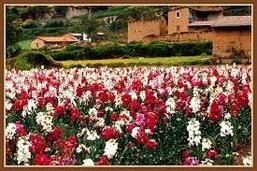
Before driving into Tarma itself, we also saw many plots with different kinds of flowers in beautiful colors. Tarma is also called “The City of Flowers.” Flowers grown here would be transported in abundance in trucks going down to Lima where they would be sold.
Tarma is situated at approximately 10,000 ft. above sea level, and the valley itself continues down towards Chanchamayo located at around 2,500ft. There the climate becomes tropical. Tarma was an old town but had grown rapidly in later years.
Tarma is situated at approximately 10,000 ft. above sea level, and the valley itself continues down towards Chanchamayo located at around 2,500ft. There the climate becomes tropical. Tarma was an old town but had grown rapidly in later years.
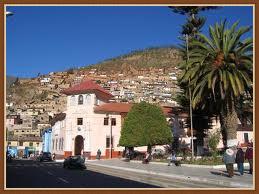
Photo on left: City street in Tarma Photo above: Beautiful fields of flowers in the valley
There were many newer buildings around the center. In 1967, when we arrived, Tarma had approximately 15- 20,000 residents. The people who live in Tarma are mostly high-mountain indigenous peoples. They speak the old Inca language: Quechua. But there are also many “mestizos” in town. “Mestizos” is what they call people who are a mix of Spaniard and native descent. Most of the inhabitants also speak Spanish.
Photo below: Market day. One could buy many types of potatoes here
There were many newer buildings around the center. In 1967, when we arrived, Tarma had approximately 15- 20,000 residents. The people who live in Tarma are mostly high-mountain indigenous peoples. They speak the old Inca language: Quechua. But there are also many “mestizos” in town. “Mestizos” is what they call people who are a mix of Spaniard and native descent. Most of the inhabitants also speak Spanish.
Photo below: Market day. One could buy many types of potatoes here

Tarma was the center of a big district and had many shops, schools, colleges, and some industries. It was also the central marketplace for buying and selling meat, fruit, and vegetables. The big market days were Thursdays and Sundays. Then the streets in the center of town were packed with people who were selling and buying agricultural products first and foremost, but also clothes, blankets, and furniture.
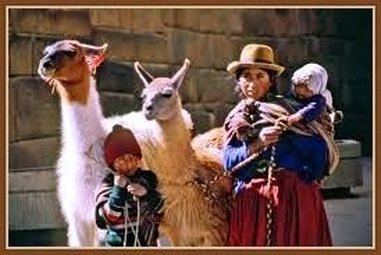
It was quite fascinating to see the llamas loaded down with different products. They were coming from different cities and villages higher up in the mountains and were led by the mountain people in their colorful outfits. The women had long braids, and most had large whitewashed, wide-brimmed hats that were the most common in this district. The hats varied depending on which city or area the wearer came from. The locals could tell where a woman was from by looking at her hat. Many of the women were knitting as they walked, or spinning yarn with handheld spindles. It had been an exciting road trip, but we were pretty tired as we arrived late Saturday afternoon!
Casa de Oracion - the church in Tarma
Reaching the people in this area with the gospel proved to be hard work. Most considered themselves Catholic, although their Catholic beliefs were often blended with ancient local customs and shamanism as well. The Catholic church had taught them to look at evangelical Christians as heretics. The shamans also had great power here like in many other places in Peru. However, by the time we arrived, many had left fear and superstition behind when they heard the word about the cross and the power of Jesus’ resurrection Those who received the gospel were saved and set free, baptized, and added to the church.
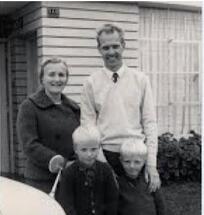
Boyan and Lennart Lindgren, missionaries from Värnamo, Sweden, joined the work in Tarma in 1962. Brita and Per Anderås moved to Huancayo, the capital of the county Junin when they came back from spending some time in Sweden. Lennart and Boyan had lived and worked in Tarma and surroundings for five years when we arrived. The plan was that we would replace them in Tarma so they could travel to Sweden for a well-deserved rest. They would be gone a year. They had been renting an apartment on the 2nd floor in one of the main streets of Tarma. The owner of the apartment had given the green light to extend the rent to the new missionaries. Both the Lindgrens and we saw it as a good solution since rent was also reasonable.
The Welcome Service" in "Casa de Oracion"
Sunday, the day after our arrival, there was Sunday school for the whole family from two to four-thirty in “Casa de Oracion”. At eight o'clock that evening our welcome service began, and it lasted till past eleven! The service was a great experience for us. There were about 125 people present, as some of the believers from places around Tarma had come as well. Consequently, the room was full when we arrived except for some seats on the front row which they had reserved for us. Both the greetings we received and the singing were lovely. John sang a song in Spanish for them, and then he preached with Lennart as an interpreter. I also said a few words with help from the interpreter. At the end of the service, several people came forward and surrendered their lives to Jesus.
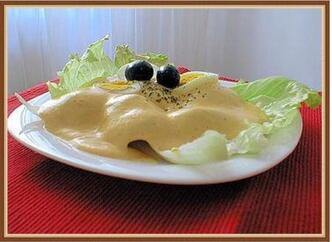
After the service, we were served dinner. There were several exciting things on the tables, including “Papa a la Huancaina ". It consists of boiled potatoes, raw onions, olives, and a strong sauce made of cheese and cracker crumbs, and seasoned with red chili peppers. We had a difficult time eating this because it was so spicy!. Tears streamed down our faces, and the napkin was constantly in use. But eventually, during our time in the mountains, we became fond of this dish and got used to the spiciness. I even made it myself, but with less chili! After the main meal, we really enjoyed the fried cakes they served next. They looked like donuts and were very good. It truly was an enjoyable time with the church! We felt we had received a very warm welcome by the congregation, and knew that we had added many new brothers and sisters in Christ to our lives. One older sister said crying as she hugged John: "What are you going to do here, you can't even speak Spanish!" That was true, we didn't know much Spanish. But we obviously wanted to learn as soon as possible!
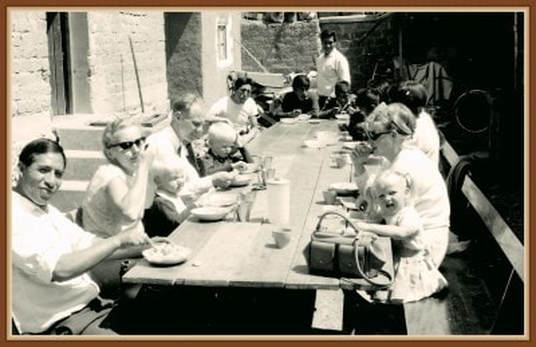
Photo: This picture in the courtyard "Casa de Oracion" was taken on a later occasion. It shows the Lindgren family with us and Peruvian workers in the ministry. Alejandro Lopes, on the left front, became the pastor of the church when we later moved to Bagua. The church and the kitchen is to the left and the pastor's apartment on the right.
Back to Lima - as told by John
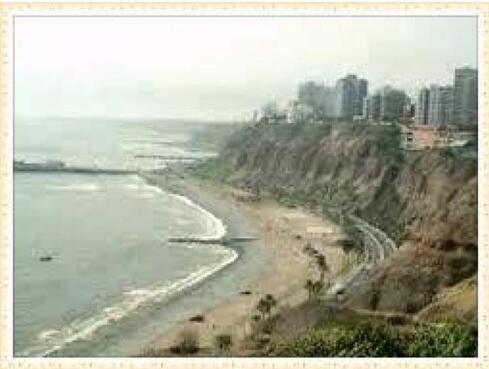
The next day we headed down to Lima again. This time Boyan Lindgren stayed behind in Tarma with their two little boys, David and Samuel. Back in Lima, we continued running around to the various offices to get everything ready for the residence permit. There was a good deal of waiting involved, both at the offices and at home, so we were able to take the time to spend a fun day on one of the beaches south of Lima. January is high summer in the southern hemisphere, but it was not so hot as to be bothersome. Just right, I would say! There are no islands outside of the coast to stop or temper the waves, so we had to be careful not to go too far out in the water. There could also be strong, dangerous outgoing currents farther out from shore. The water was surprisingly cold, too! This was due to the cold Humboldt stream that comes up from Antarctica along the coast of Chile and Peru. We still really enjoyed the experience of swimming in the waves of the Pacific Ocean!
Another day we visited the Scandinavian Seamen's Church. There we met the friendly Swedish priest and his wife. We also got to know the Norwegian assistant and housekeeper. We ended up visiting the church many times over the years, especially during our time in Tarma. I didn’t know at the time, but the following year I would be the substitute priest for the sailors for three weeks. One of my responsibilities during those three weeks would be the funeral service of the Danish consul with many prominent guests. I could never have imagined this as we were visiting the church this first time! To everyone's delight, the documents were completed during the week. Before the weekend we were back in Tarma with our Peruvian identity and residence permit papers. Finally, everything was ready to begin the work we had come to do.
As it turned out, however, another trip to Lima became necessary as government officials decided there was still something more that needed to be arranged in regard to our documents. In addition to that, the Lindgrens had to go and buy plane tickets back to Sweden and get some papers to allow them to leave Peu. Originally they had booked tickets to travel home on a Swedish boat, but then they received a message that there was no room for them on the boat after all. They were certainly happy to be able to fly instead. Many prayers of thanks rose up to the Lord when all this was arranged. Now we could look forward to starting the work in Tarma with help and guidance from the Lindgrens for a couple of months until they returned to Sweden.
Another day we visited the Scandinavian Seamen's Church. There we met the friendly Swedish priest and his wife. We also got to know the Norwegian assistant and housekeeper. We ended up visiting the church many times over the years, especially during our time in Tarma. I didn’t know at the time, but the following year I would be the substitute priest for the sailors for three weeks. One of my responsibilities during those three weeks would be the funeral service of the Danish consul with many prominent guests. I could never have imagined this as we were visiting the church this first time! To everyone's delight, the documents were completed during the week. Before the weekend we were back in Tarma with our Peruvian identity and residence permit papers. Finally, everything was ready to begin the work we had come to do.
As it turned out, however, another trip to Lima became necessary as government officials decided there was still something more that needed to be arranged in regard to our documents. In addition to that, the Lindgrens had to go and buy plane tickets back to Sweden and get some papers to allow them to leave Peu. Originally they had booked tickets to travel home on a Swedish boat, but then they received a message that there was no room for them on the boat after all. They were certainly happy to be able to fly instead. Many prayers of thanks rose up to the Lord when all this was arranged. Now we could look forward to starting the work in Tarma with help and guidance from the Lindgrens for a couple of months until they returned to Sweden.




